An interesting development project on the edge of DC that redefines opportunity in terms of access to Maryland
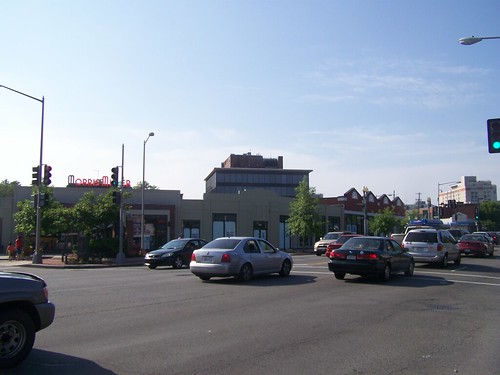 Douglas Development is a major DC real estate firm that owns property all around the city (and plenty of property in Suburban and exurban Maryland, including Frederick, as well as Richmond, Virginia).
Douglas Development is a major DC real estate firm that owns property all around the city (and plenty of property in Suburban and exurban Maryland, including Frederick, as well as Richmond, Virginia). Right: Douglas Development strip retail at Georgia and Eastern Avenues NW, in Washington, DC.
The company has a history of buying as much property as they can, holding on to it forever, and eventually getting around to developing it--they are focused on getting top dollar rents, and will keep properties empty until they do.
That being said, the company has been willing to adaptively reuse historic buildings in reasonably acceptable ways (with some setbacks to be sure), they are creative, and they will take chances on tough properties even if some of their ideas are wacked and they have to go through a couple iterations to shake off the crazy stuff.
More recently they have pushed a lot of buttons with a project on Wisconsin Avenue NW in the vicinity of Tenleytown Metro Station, where they will be building condos without parking spaces ("Battle Of Babe's Ends With Approval Of Parking-Free Building" from the Washington City Paper) in a project called Tenley View.
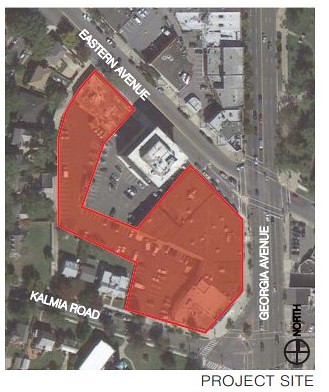 They've owned a piece of property at Georgia Avenue and Eastern Avenue NW, on the DC side, right on the DC-Maryland line, for about 15 years (site image left) and it's been rented out to a variety of retailers.
They've owned a piece of property at Georgia Avenue and Eastern Avenue NW, on the DC side, right on the DC-Maryland line, for about 15 years (site image left) and it's been rented out to a variety of retailers.Grainger was there for awhile but they closed this location when they opened a store on Florida Avenue NE a few years ago. The liquor store is in a decent art deco building, but the other buildings are for the most part nondescript.
They own most of the block, except for a few houses on Kalmia Street and an office building on Eastern Avenue.
They propose a 6 story building with 220 apartments and a Harris-Teeter supermarket on the ground floor. Obviously, H-T wants to be there not so much to sell to DC customers as much as to be present in the Silver Spring market, which is already served by Giant, Safeway, and Whole Foods.
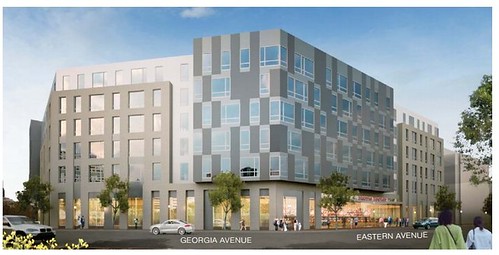 It's interesting too because it's a DC-based project designed to attract Maryland customers, when typically it worked the other way, where commercial developments were developed just outside the DC line in Maryland, fully expecting to attract DC customers.
It's interesting too because it's a DC-based project designed to attract Maryland customers, when typically it worked the other way, where commercial developments were developed just outside the DC line in Maryland, fully expecting to attract DC customers. For example, the Giant Supermarket in Friendship Heights is on the Maryland side of Western Avenue; a Giant moved from a shopping center on Riggs Road in DC to a similar location just on the other side of Eastern Avenue in Hyattsville; or the Safeway in Good Hope Marketplace in Prince George's County, etc.)
That part of the city, from the standpoint of DC, is not developed very densely, because it is on "the edge" of the city--being six miles north of Downtown. But while it is far from Downtown DC, it's 3/4 mile from the Silver Spring Metro and the burgeoning business and residential district that has
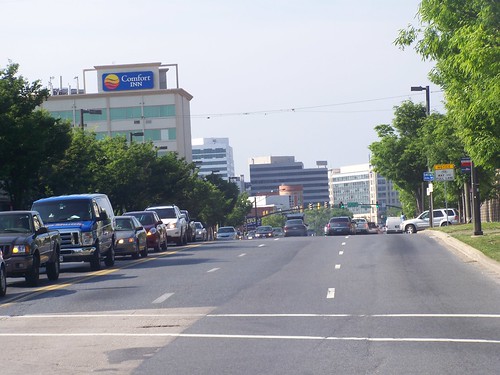 Left: South Silver Spring, looking northward towards Colesville Road.
Left: South Silver Spring, looking northward towards Colesville Road.It's also on the edge of South Silver Spring, which is going through its own intensification (see "South Silver Spring residents split over proposed apartments" from GGW). Mostly, DC residents proximate to the area just see this as Marylanders swiping their DC parking.
There was an interesting piece about the debacle of the Silver Spring Transit Center in the Post on Sunday ("How Silver Spring's transit center plan grew into a fiasco") and it made the point that they came up with the Transit Center as a way to communicate to commercial tenants and office developers that the County was committed to revitalization. Instead it's become a $120+ million debacle. From the article:
For years, Silver Spring searched for a savior. ... Meanwhile, businesses kept leaving, 220 of them in the decade prior to 1996.
County planners were convinced that public money could create magnets that would attract private investment and popular interest in living, working and playing in Silver Spring. The key, some said, was transit. “For Silver Spring to accommodate more commerce and be a major source of jobs, we had to have more people using transit,” said Ed Daniel, a retired county transportation planner who played a central role in getting the transit center started.
In 1993, federal, state and county officials announced plans for a $26 million terminal to link commuter and Metro trains, Metro and Ride-On buses, and taxis. ...
The transit center would expand from a glorified bus stop to a three-level economic engine linking three sections of downtown, providing a steady stream of pedestrians to walk to the new restaurants, theaters and a new skating rink and civic center.
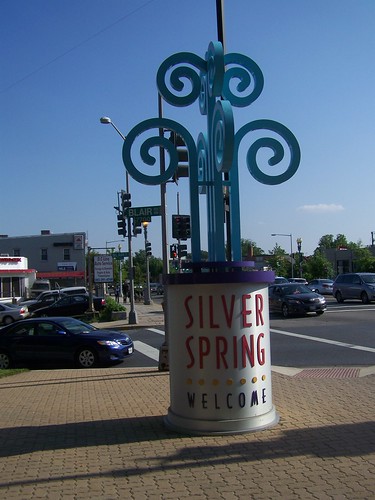
Instead, they should have built an infill subway station right on the edge of Maryland and DC in South Silver Spring--just like how DC built an infill subway station for what is now called the NoMA district ("NoMa: The Neighborhood That Transit Built," Urban Land Institute).
It's about one mile from the intersection of Georgia and Eastern Avenues to the Silver Spring Metro station, plenty of distance that justifies another station--Arlington has four stations in two miles, between the Courthouse and Ballston Metro Stations. DC has three stations in about 1.3 miles, between Potomac Avenue Metro and Capitol South Metro.
Retrospect being easy, I'd argue that Montgomery County would have gotten way more economic benefit from that, although DC would have received some benefit as well, especially if they would have considered some upzoning on the DC side of "South Silver Spring" and they would have had the added benefit of WMATA being responsible for constructing the station instead of the consortium that screwed up the Transit Center.
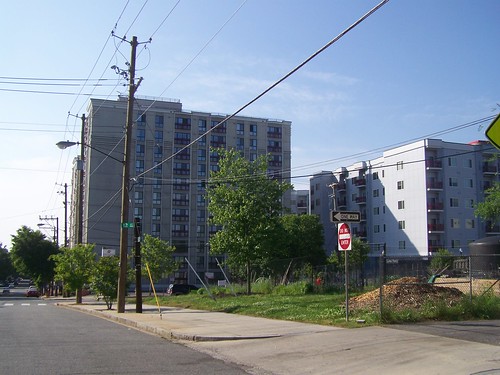 Left: An apartment building on the Silver Spring side of Eastern Avenue NW.
Left: An apartment building on the Silver Spring side of Eastern Avenue NW.Similarly, there is/was a joint jurisdiction community development corporation focused on revitalization of Upper Georgia Avenue in DC and South Silver Spring in Maryland, Gateway Georgia Avenue Revitalization Corporation. They didn't do all that much and now the organization is defunct. Probably an infill subway station would have done way more than anything else they could have done.
Labels: commercial district revitalization planning, real estate development, transit oriented development, transportation planning



4 Comments:
I wouldn't say that Silver Spring developed within the past 15 years. The business district has been there since the early 20th century, and in the 1950's it was a regional destination. The latest round of investment has taken place within the past 15-20 years, but it was a significant downtown before then.
I'm also not sure if Harris Teeter is specifically geared towards Silver Spring customers, though the population density is much higher on our side. The neighborhoods on the DC side, Shepherd Park and North Portal Estates, are very affluent as well, along with the Gold Coast.
Either way, the idea of adding a new Metro station is interesting. I'm not sure if it would've negated the need for the Transit Center, since many of the buses feeding into it come from the north.
1. YOu're absolutely right. I meant the revitalization piece, as was discussed in the Post article I mentioned. Obviously, SS was a commercial district and post war had quite a burgeoning growth for a time, but it suffered from malls and outmigration too.
2. The point about the "Transit Center" is that was one really needed, buses were and are already getting to and from the area without it.
Granted the structure is needed, in order to increase capacity.
You don't need a big building to do the "yard" necessarily, as is proven by many of the Metro stations across the region, which provide access to the station by bus.
3. More importantly, I am talking about economic value generated by the investment. There will be limited return on the Transit Center, if anything, whereas a Metro Station, for the same money (had it been built 10-15 years ago), would have probably returned between 10 and 20 $ per each $ invested.
I revised that sentence to be clearer.
2. I also forgot to respond to your point about H-T. I disagree. While sure they want to get business from Upper DC, the action and density is in Silver Spring and this is a cheap way for them to benefit from both sides of the DC-MD line.
They locate their stores in denser places (e.g., Capitol Hill, NoMA, Kalorama) and so upper northwest would normally be a "no"-brainer, except in Friendship Heights.
This is one of those rare incidents where DC will benefit from cross-line commerce, which I thought made this worth writing about.
I didn't have idea about all this stuff. Ia m planning to buy a home in DC, have checked sites like www.yasminhomes.com and liked the listings.
Post a Comment
<< Home